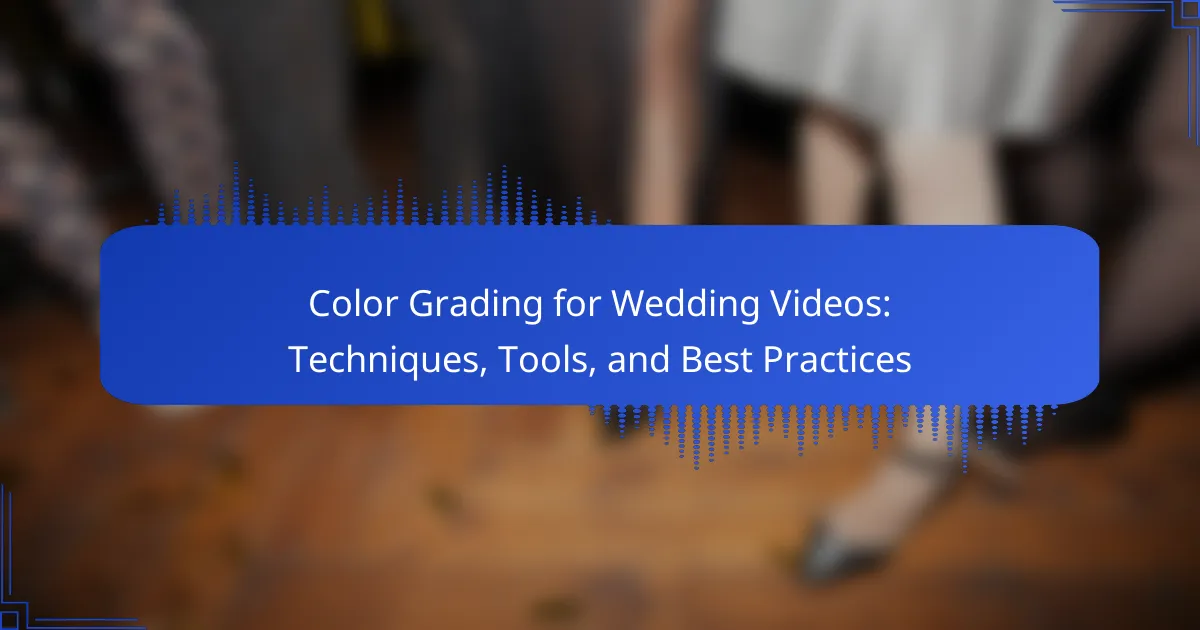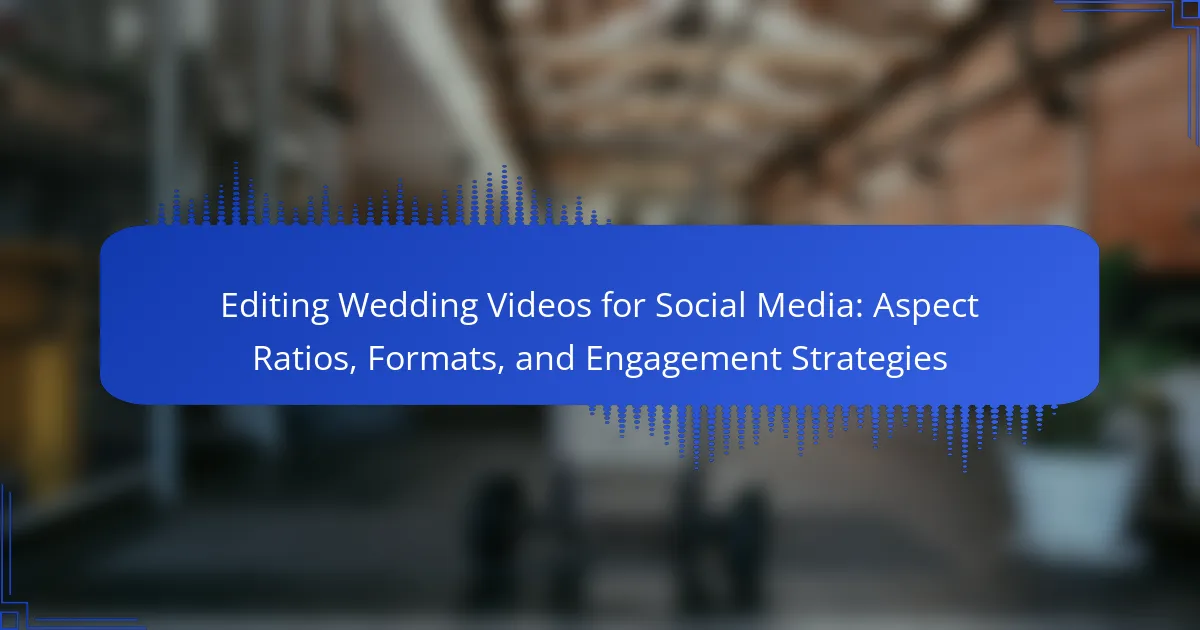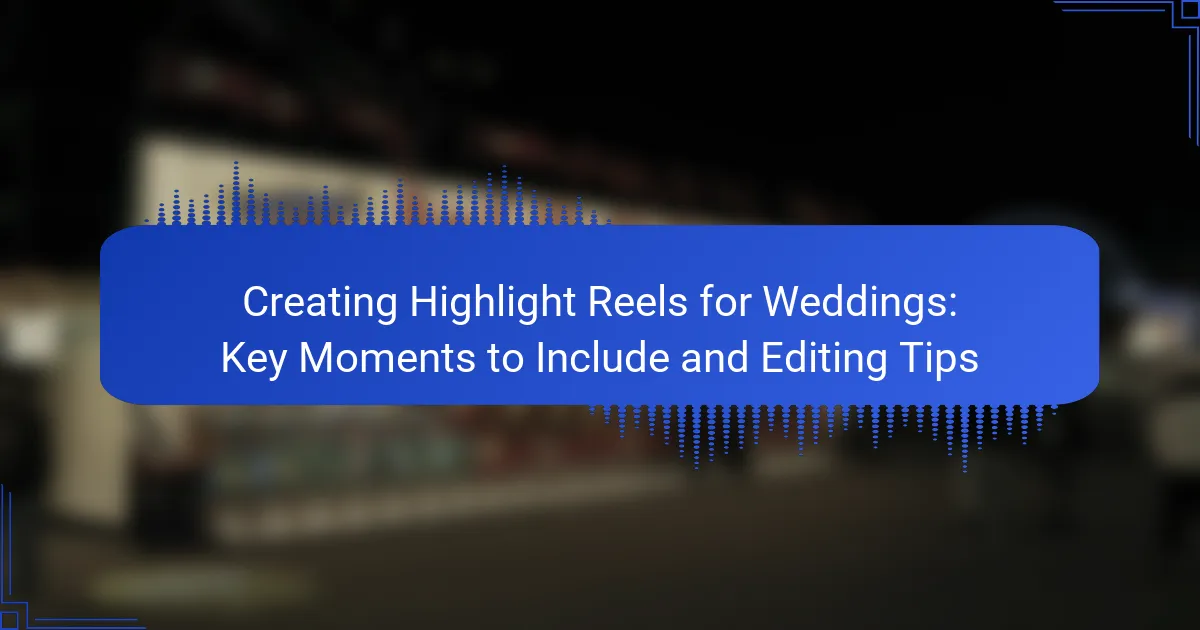Color grading for wedding videos is the process of adjusting and enhancing the colors in footage to improve visual aesthetics and mood. This technique involves altering brightness, contrast, saturation, and hue to ensure color consistency and evoke specific emotions. Key techniques include color correction, color enhancement, and the application of Look-Up Tables (LUTs), along with skin tone adjustments and secondary color grading for selective enhancements. Essential tools for color grading include professional software like Adobe Premiere Pro and DaVinci Resolve, calibrated monitors for accurate color representation, and color grading panels for efficient workflow. The article covers these techniques and tools, providing best practices for achieving a polished final product that enhances the storytelling of wedding videos.
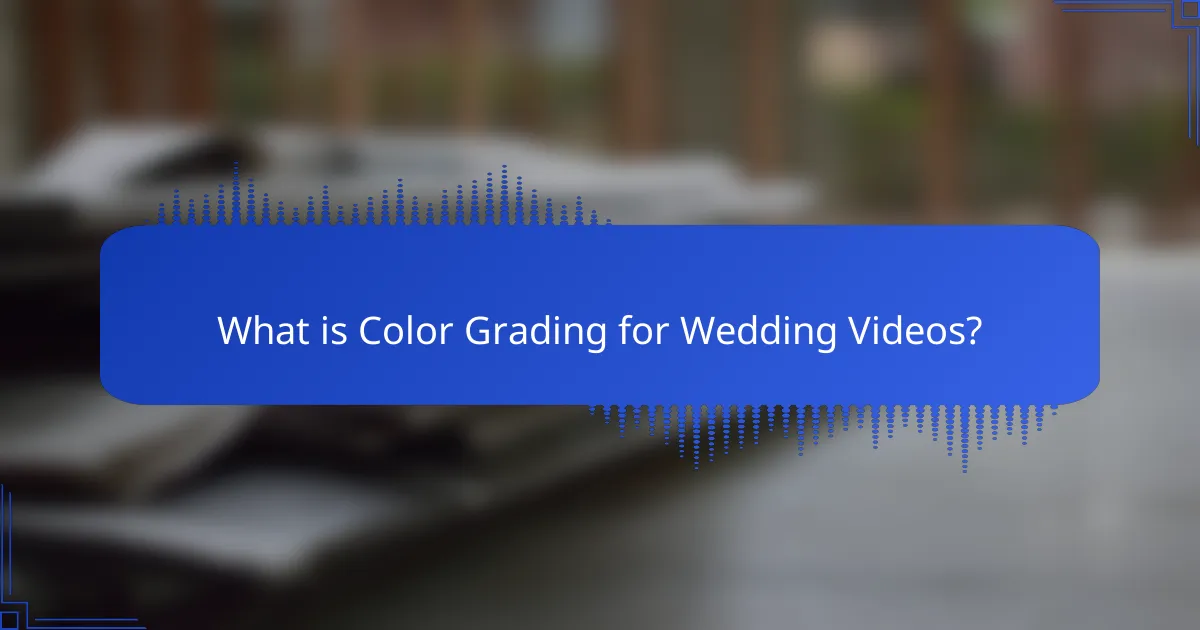
What is Color Grading for Wedding Videos?
Color grading for wedding videos is the process of adjusting and enhancing the color of the footage. This technique improves the visual aesthetics and mood of the video. Color grading involves altering brightness, contrast, saturation, and hue. It ensures that the colors are consistent throughout the video. Different styles can evoke specific emotions, such as warmth or nostalgia. The process often uses software like Adobe Premiere Pro or DaVinci Resolve. Color grading can significantly impact the overall storytelling of the wedding video. It transforms raw footage into a polished final product.
How does color grading enhance wedding videos?
Color grading enhances wedding videos by improving the visual aesthetics and emotional impact. It adjusts colors to create a specific mood or atmosphere. For instance, warm tones can evoke feelings of romance. Cool tones may convey calmness or tranquility. Color grading also ensures consistency across different shots. This creates a cohesive look throughout the video. Additionally, it can highlight important moments, drawing attention to key emotions. Studies show that well-graded videos are more engaging for viewers. Overall, color grading transforms raw footage into a polished, professional final product.
What are the key elements of color grading in videography?
The key elements of color grading in videography include color balance, contrast, saturation, and creative color effects. Color balance adjusts the overall color temperature of a video. It ensures that whites appear neutral and colors are true to life. Contrast enhances the difference between light and dark areas, adding depth. Saturation affects the intensity of colors, making them more vibrant or muted. Creative color effects allow for stylistic choices, such as color isolation or mood setting. These elements work together to enhance the visual storytelling in videography.
How does color grading impact the emotional tone of wedding videos?
Color grading significantly impacts the emotional tone of wedding videos. It alters the visual aesthetics, influencing how viewers perceive the emotions conveyed. Warm tones evoke feelings of happiness and intimacy. Cool tones can create a sense of calm or nostalgia. High contrast can enhance drama, while softer tones may suggest tenderness. Research indicates that color influences emotional responses; for instance, studies show that specific hues can trigger distinct feelings. By carefully selecting colors, videographers can enhance storytelling and emotional resonance in wedding videos.
Why is color grading important in wedding videography?
Color grading is important in wedding videography because it enhances the visual storytelling. It allows videographers to create a specific mood or atmosphere that reflects the couple’s emotions. Proper color grading can unify different shots, making the video feel cohesive. It also helps to correct any color imbalances from the original footage. Studies show that well-graded videos can increase viewer engagement. High-quality color correction can elevate the overall production value. This ensures that the final product looks professional and polished. Ultimately, effective color grading contributes to preserving the memories of the day in a visually stunning way.
What are the common misconceptions about color grading?
Common misconceptions about color grading include the belief that it’s merely about making footage look pretty. Color grading actually involves correcting colors, enhancing mood, and ensuring consistency across shots. Another misconception is that it can fix poor lighting or bad footage. While color grading can improve certain aspects, it cannot fully salvage low-quality recordings. Some people think color grading is only for professionals. In reality, many accessible tools allow beginners to experiment with color grading. Additionally, there’s a belief that color grading is a one-size-fits-all process. Each project requires a unique approach based on the desired aesthetic and narrative. Lastly, some think color grading is a quick process. In truth, effective color grading often requires significant time and attention to detail.
How does color grading differentiate professional wedding videos from amateur ones?
Color grading differentiates professional wedding videos from amateur ones by enhancing visual storytelling and emotional impact. Professionals use advanced software to adjust colors, contrast, and saturation. This process creates a cohesive look that aligns with the couple’s vision. It also helps to evoke specific moods, such as warmth or nostalgia. In contrast, amateur videos often lack consistent color grading, leading to a disjointed appearance. Professional color grading can also correct lighting issues, ensuring skin tones appear natural. Studies show that well-graded videos are more engaging and memorable for viewers. Therefore, effective color grading is a key factor in distinguishing professional quality from amateur efforts.
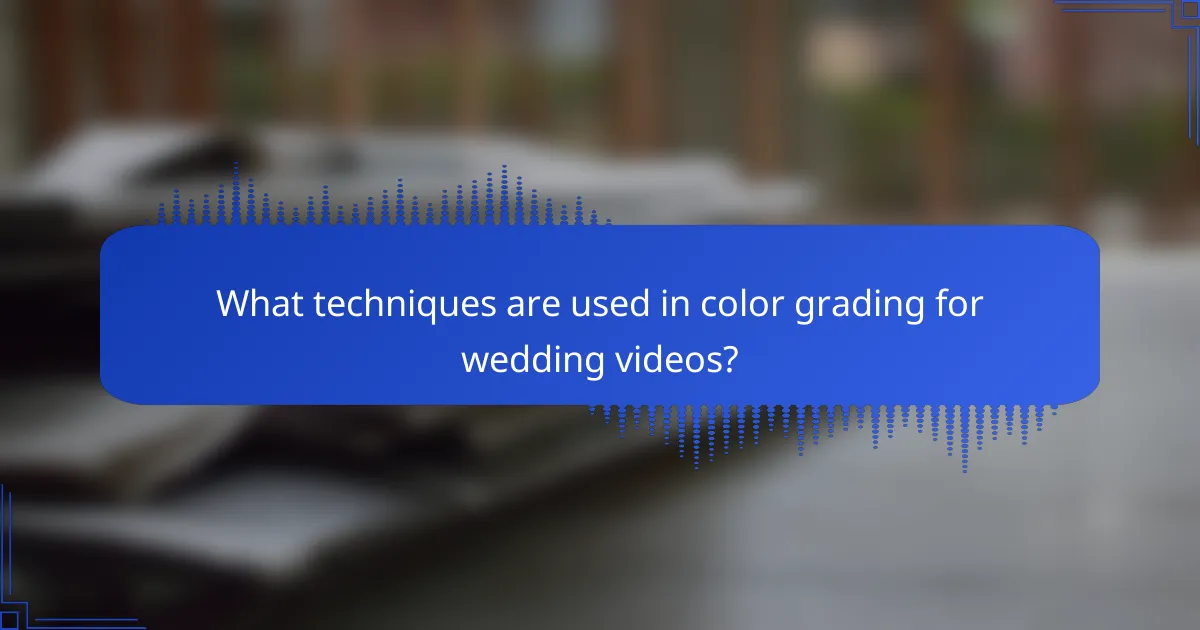
What techniques are used in color grading for wedding videos?
Techniques used in color grading for wedding videos include color correction, color enhancement, and LUT application. Color correction adjusts exposure, white balance, and contrast to achieve a natural look. Color enhancement adds vibrancy and mood by manipulating saturation and hue. LUTs, or Look-Up Tables, provide predefined color settings for consistent grading. Additionally, skin tone adjustments ensure natural appearance for subjects. The use of secondary color grading allows for selective adjustments to specific areas. Finally, film grain can be added for a cinematic feel. These techniques collectively enhance the visual storytelling of wedding videos.
How can color correction improve wedding footage?
Color correction can significantly enhance wedding footage by ensuring accurate color representation. It helps to balance skin tones, making them look natural and appealing. Correcting exposure and contrast improves overall image clarity and vibrancy. Color correction also allows for the adjustment of white balance, eliminating unwanted color casts. This process can unify the visual aesthetic across different lighting conditions. Improved color consistency creates a more professional and polished final product. According to studies, well-corrected footage can increase viewer engagement and emotional impact. Thus, color correction is essential for delivering high-quality wedding videos.
What is the difference between color correction and color grading?
Color correction and color grading are distinct processes in video production. Color correction involves adjusting the footage to achieve accurate color representation. This includes fixing exposure, white balance, and contrast. The goal is to ensure that the colors appear natural and consistent.
In contrast, color grading is a creative process that adds style and mood to the footage. It involves applying artistic color adjustments to enhance the visual storytelling. Color grading can manipulate hues, saturation, and luminance for dramatic effects.
Both processes are essential in post-production. According to the American Society of Cinematographers, color correction is typically performed before color grading to ensure a solid foundation for creative choices.
What tools can be used for effective color correction?
Effective color correction can be achieved using various tools. Popular software includes Adobe Premiere Pro, which offers comprehensive color grading features. DaVinci Resolve is another powerful option, known for its advanced color correction capabilities. Final Cut Pro also provides robust color grading tools suitable for wedding videos. Additionally, Colorista from Red Giant is a specialized plugin that enhances color correction workflows. Each of these tools allows for precise adjustments to color balance, saturation, and contrast, ensuring high-quality results in wedding videography.
What creative color grading techniques can be applied?
Creative color grading techniques include the use of LUTs, split toning, and color wheels. LUTs, or Look-Up Tables, can transform colors to achieve a specific mood. Split toning involves adjusting the highlights and shadows separately to create a unique look. Color wheels allow for precise adjustments to shadows, midtones, and highlights. Additionally, the use of masks can isolate specific areas for targeted color adjustments. Overlaying textures can add depth and interest to the footage. These techniques enhance the visual storytelling in wedding videos, providing a more emotional and artistic presentation.
How do LUTs (Look-Up Tables) enhance wedding video color grading?
LUTs (Look-Up Tables) enhance wedding video color grading by providing a standardized way to apply color corrections and creative looks. They simplify the color grading process by mapping input colors to desired output colors. This allows for consistent color grading across different clips. LUTs can emulate specific film stocks or create unique visual styles. They also save time by offering instant results, which is crucial in wedding videography. Many professional editing software programs support LUTs, making them accessible to videographers. Studies show that using LUTs can improve workflow efficiency by up to 30%. This efficiency is vital during the fast-paced editing required for wedding videos.
What are some popular color grading styles for wedding videos?
Some popular color grading styles for wedding videos include cinematic, vintage, and pastel. Cinematic color grading enhances contrast and saturation. This style creates a dramatic and film-like appearance. Vintage color grading often features warm tones and soft contrasts. It evokes a nostalgic feel, reminiscent of old films. Pastel color grading uses soft hues and light contrasts. This style gives a dreamy and romantic atmosphere. Each style can be tailored to match the couple’s preferences and the overall tone of the wedding.

What tools are essential for color grading wedding videos?
Essential tools for color grading wedding videos include professional software, hardware for monitoring, and color grading panels. Software like DaVinci Resolve and Adobe Premiere Pro provides advanced color correction features. These applications support various formats and offer extensive color grading tools. Hardware such as calibrated monitors ensures accurate color representation. A color grading panel, like the Tangent Ripple, enhances workflow efficiency. These tools allow videographers to achieve cinematic looks and maintain consistent color throughout the video. Using these essential tools contributes to the overall quality of wedding videos.
What software options are available for color grading?
Software options available for color grading include DaVinci Resolve, Adobe Premiere Pro, Final Cut Pro, and Avid Media Composer. DaVinci Resolve is renowned for its advanced color correction tools and is widely used in the industry. Adobe Premiere Pro offers integrated color grading features that are user-friendly. Final Cut Pro is known for its seamless workflow and powerful color grading capabilities. Avid Media Composer is favored for its robust editing and color grading tools, especially in professional environments. Each of these software options provides unique features that cater to different user needs in color grading.
Which software is best suited for beginners in wedding videography?
Adobe Premiere Elements is best suited for beginners in wedding videography. This software offers an intuitive interface that simplifies video editing tasks. It includes guided edits that help users learn as they create. Premiere Elements supports various formats, making it versatile for different camera outputs. The software also features automated options for color correction and enhancements. Additionally, it provides access to a library of effects and transitions. This helps beginners produce polished videos with minimal experience. Overall, Adobe Premiere Elements balances functionality and ease of use for novice videographers.
What advanced software features should professionals look for?
Professionals should look for advanced software features such as color wheels, LUT support, and advanced masking tools. Color wheels allow precise adjustments to hue, saturation, and luminance. LUT support enables the application of creative color grading styles quickly. Advanced masking tools facilitate selective color adjustments for specific areas in the video. Real-time playback ensures smooth editing without lag. Collaboration features allow multiple users to work on the same project efficiently. High dynamic range (HDR) support enhances the range of colors and brightness levels. These features significantly enhance the color grading process for wedding videos, ensuring high-quality results.
What hardware is recommended for optimal color grading?
High-performance hardware is recommended for optimal color grading. A powerful CPU, such as an Intel i7 or AMD Ryzen 7, ensures efficient processing. A dedicated GPU, like NVIDIA GeForce RTX 3060 or AMD Radeon RX 6700 XT, enhances rendering capabilities. At least 16 GB of RAM is essential for handling large video files. A high-resolution monitor, ideally 4K with accurate color reproduction, is crucial for precise adjustments. Additionally, a calibrated monitor will ensure color accuracy. Using SSDs for storage improves read/write speeds, facilitating smoother playback and editing. These hardware specifications are commonly endorsed by industry professionals for effective color grading.
How do monitors and calibration affect color grading results?
Monitors and calibration significantly impact color grading results. Accurate monitors display colors true to life. Calibration ensures that the monitor’s color output matches industry standards. This process involves adjusting settings like brightness, contrast, and color balance. Without proper calibration, colors may appear distorted or inconsistent. Inconsistent colors can lead to poor grading choices. Professional colorists rely on calibrated monitors for precise adjustments. Studies show that uncalibrated monitors can misrepresent colors by over 20%. Thus, proper calibration is essential for achieving desired visual outcomes.
What are the benefits of using dedicated color grading panels?
Dedicated color grading panels enhance workflow efficiency and precision in color correction. They provide tactile control over color adjustments, allowing for quicker and more intuitive editing. These panels often feature customizable buttons and dials, streamlining the grading process. The ergonomic design reduces strain during long editing sessions. Dedicated panels also offer improved accuracy in color representation compared to standard mouse controls. This leads to better consistency in color grading across projects. Many professionals report increased productivity when using dedicated panels. Studies show that using specialized tools can decrease editing time by up to 30%.
What are the best practices for color grading wedding videos?
The best practices for color grading wedding videos include maintaining consistency, using a color palette, and enhancing emotions. Consistency ensures that all clips match in color tones and styles. A cohesive color palette creates a unified look across the video. Enhancing emotions with color can evoke the right feelings, making the footage more impactful.
Utilizing software like DaVinci Resolve or Adobe Premiere Pro offers powerful tools for color grading. Techniques such as adjusting exposure, contrast, and saturation are essential. Additionally, applying LUTs (Look-Up Tables) can streamline the grading process.
Finally, always review the final output on different devices. This ensures that colors appear as intended across various screens. Following these practices results in a polished and professional wedding video.
How can one ensure consistency in color grading across different clips?
To ensure consistency in color grading across different clips, use a color grading software with a color correction tool. Begin by establishing a color grading preset that aligns with your desired look. Apply this preset uniformly across all clips to maintain a cohesive aesthetic. Utilize scopes, such as waveform and vectorscope, to monitor color levels and ensure they match across clips. Additionally, reference stills from your clips to maintain color balance. Always adjust lighting and exposure before grading, as these factors influence color perception. Lastly, consider using LUTs (Look-Up Tables) for a standardized color grading approach.
What are common mistakes to avoid in color grading wedding videos?
Over-saturation is a common mistake in color grading wedding videos. It can lead to unnatural skin tones and distract from the emotional moments. Another mistake is inconsistent color grading across different scenes. This inconsistency can disrupt the flow of the video. Ignoring the lighting conditions during the shoot is also a significant error. Each lighting scenario requires specific adjustments to maintain visual coherence. Failing to use reference monitors can result in inaccurate color representation. This can lead to discrepancies when viewed on different devices. Lastly, neglecting the importance of color harmony can make the video visually unappealing. Ensuring complementary colors enhances the overall aesthetic.
What tips can improve color grading skills for wedding videographers?
To improve color grading skills for wedding videographers, practice regularly with different footage. Experiment with various color grading software like DaVinci Resolve or Adobe Premiere Pro. Understand the color wheel and its application for creating mood and emotion. Use LUTs (Look-Up Tables) to streamline the grading process and achieve consistent looks. Analyze professional wedding videos to identify effective color grading techniques. Pay attention to skin tones to ensure they appear natural and appealing. Utilize scopes and histograms to monitor color balance and exposure accurately. Lastly, seek feedback from peers or mentors to refine your skills and approach.
Color grading for wedding videos is the process of adjusting and enhancing footage colors to improve visual aesthetics and emotional impact. This article covers the techniques, tools, and best practices essential for effective color grading, including color correction, LUT application, and the use of professional software like DaVinci Resolve and Adobe Premiere Pro. Key elements such as color balance, contrast, and saturation will be discussed, along with their influence on the emotional tone of wedding videos. Additionally, common misconceptions and mistakes in color grading, as well as tips for improving skills, will be addressed to help videographers achieve polished and professional results.
